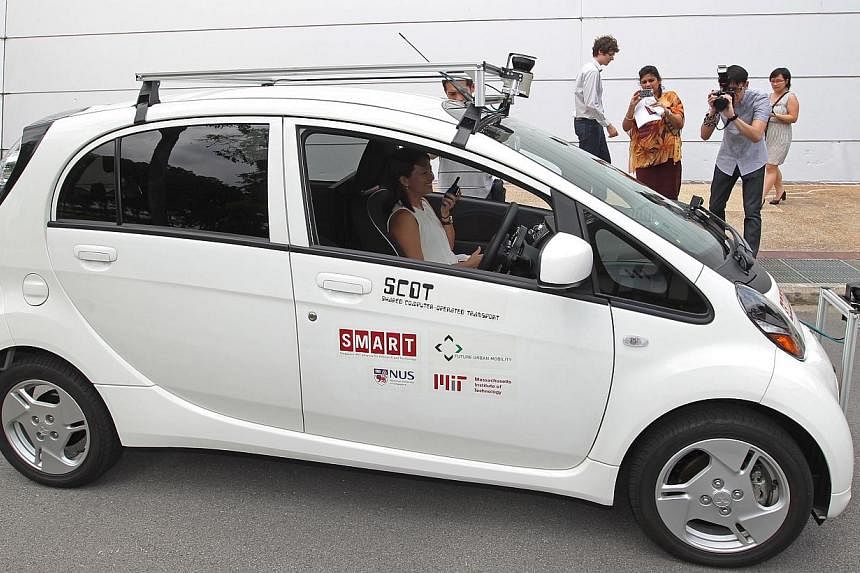ADDING to its vast portfolio of transportation-related acronyms, the Ministry of Transport yesterday announced the launch of Carts - the Committee for Autonomous Road Transport for Singapore.
As the committee brings together expertise from different backgrounds surrounding mobility, several questions are poised to emerge: What could autonomous (or self-driving) vehicles do for Singapore? And, more generally, what is the status of the technology today?
Cars have been undergoing a gradual transformation from the kinds of mechanical systems Henry Ford might have imagined, to become computers on wheels. That transformation is bringing with it a new wave of digital advances - most relevantly, autonomous vehicles (AVs).
The first autonomous (or self-driving) cars date back to the late 20th century, but recent advances in sophistication and reductions in cost - such as cheap Lidar (light and radar) systems, which can "see" a street in 3D, similar to the human eye - are now bringing driverless cars closer to the market.
Several manufacturers are working towards integrating such systems into their fleets, and expect to start selling premium cars with different degrees of autonomy as early as 2016. According to a recently released report, in a few decades, virtually all vehicles on the road might be self-driving.
As this revolution develops, it will certainly transform our daily routines: imagine driving hands-free while having the luxury of reading a book, taking a nap, or guiltlessly texting on the road. At the same time, something far more interesting - and still unexplored - is the potential transformation of our cities themselves.
AVs promise a dramatic impact by blurring the distinction between private and public modes of transportation. "Your" car could give you a lift to work in the morning and then, rather than sitting idle in a parking lot, give a lift to someone else in your family - or, for that matter, to anyone else in your neighbourhood, social media circles, or city.
A recent paper by the Massachusetts Institute of Technology's Smart Future Mobility team shows that the mobility demand of a city like Singapore could be met with 30 per cent of its existing vehicles.
Furthermore, other researchers in the same group suggest this number could be cut by another 40 per cent if passengers travelling on similar routes at the same time were willing to share a vehicle - an estimate supported by an analysis of the "shareability" networks of New York City taxis.
This implies a city in which everyone can travel on demand with just one-fifth of the number of cars in use today.
Such reductions in vehicle traffic would dramatically lower the cost of our mobility infrastructure and the embodied energy associated with building and maintaining it. Fewer cars may also mean shorter travel times, less congestion, and a smaller environmental impact.
The deployment of more intelligent transportation systems promises to deliver similar benefits. Real-time data planning and smart routing are already a reality, and more advances are coming in the wake of "intelligent city" initiatives around the world, such as Singapore's "Smart Nation" project.
Tomorrow's AVs will prompt another tide of innovation, from optimised road capacity to intersection management. Imagine a world without traffic lights, where vehicular flows "magically" pass through one another and avoid collision.
While the world's mobility challenges will increasingly be met by silicon rather than asphalt, widespread adoption requires a guarantee that tomorrow's streets are as safe - or safer - than today's.
Traffic accidents, though rarer, would still be a possibility; in fact, they might be one of the main impediments to implementation of autonomous systems, demanding a restructuring of insurance and liability that could sustain armies of lawyers for years to come.
Finally, there is the issue of digital security. We are all familiar with viruses crashing our computers, but what if a virus crashes our cars? Resolving these issues is crucial, but none is insurmountable. Each will be addressed as autonomy redefines transportation and sparks the next generation of innovations in the field.
Government-supported experimentation in a country such as Singapore - with its pioneering attitude towards mobility and a living-lab condition that nurtures controlled technological experimentation - could lead to a model for smart urban mobility worldwide.
The Carts' task is ambitious, as it aims to leapfrog the island into an era of autonomous driving. Stated goals include "studying and test-bedding the various AV technologies in our environment, laying the legal, regulatory and liability framework to govern the operations of AVs, and exploring industry development and business opportunities".
All this will contribute, more broadly, to "visioning and designing a new transport mobility concept" - an exciting ambition indeed, to pave the road ahead.
Carlo Ratti is a member of Carts; he directs the Senseable City Lab at MIT and is a principal investigator at the Singapore-MIT Alliance for Research and Technology. Matthew Claudel is a research fellow at the MIT Senseable City Laboratory.

